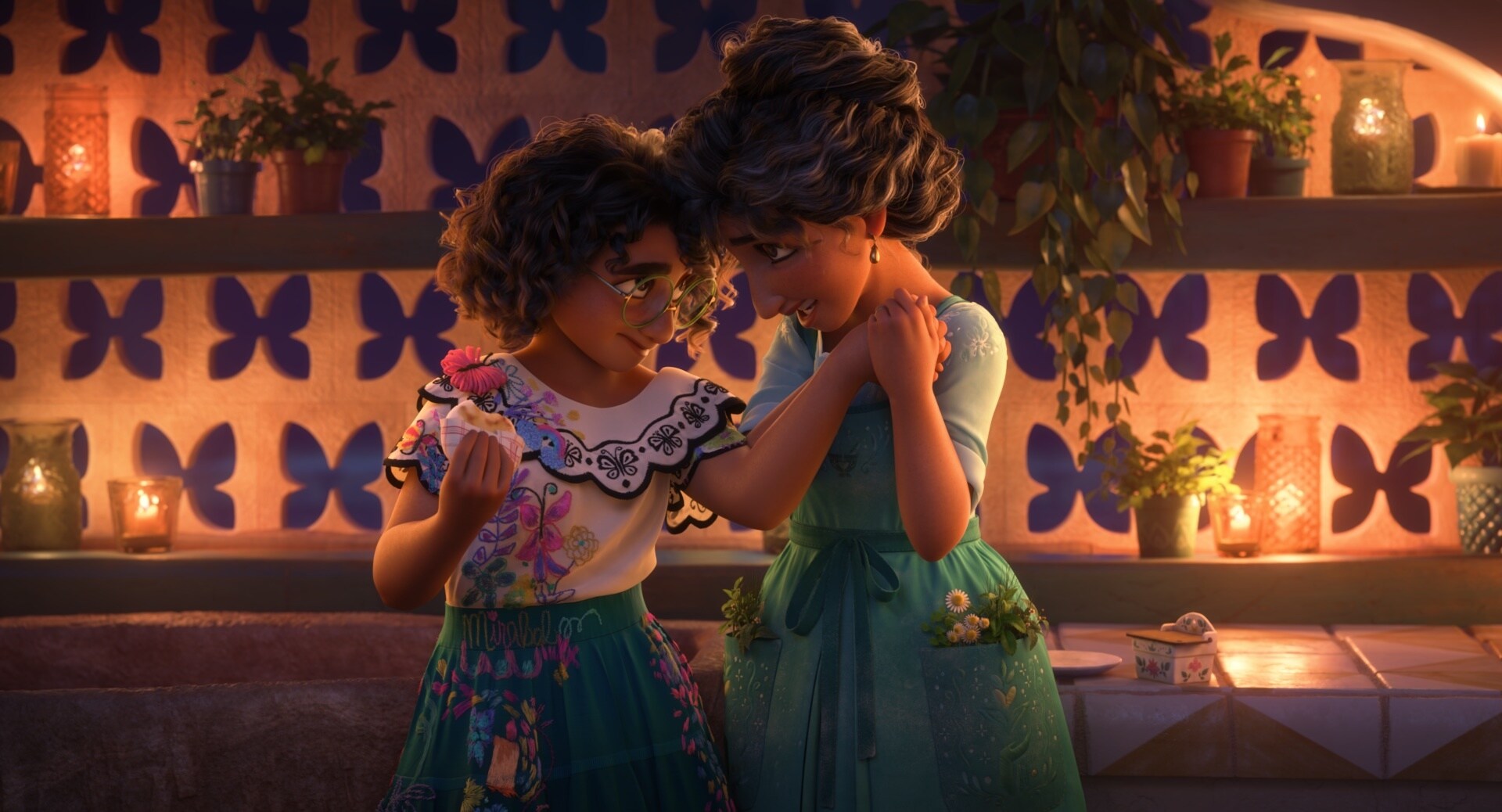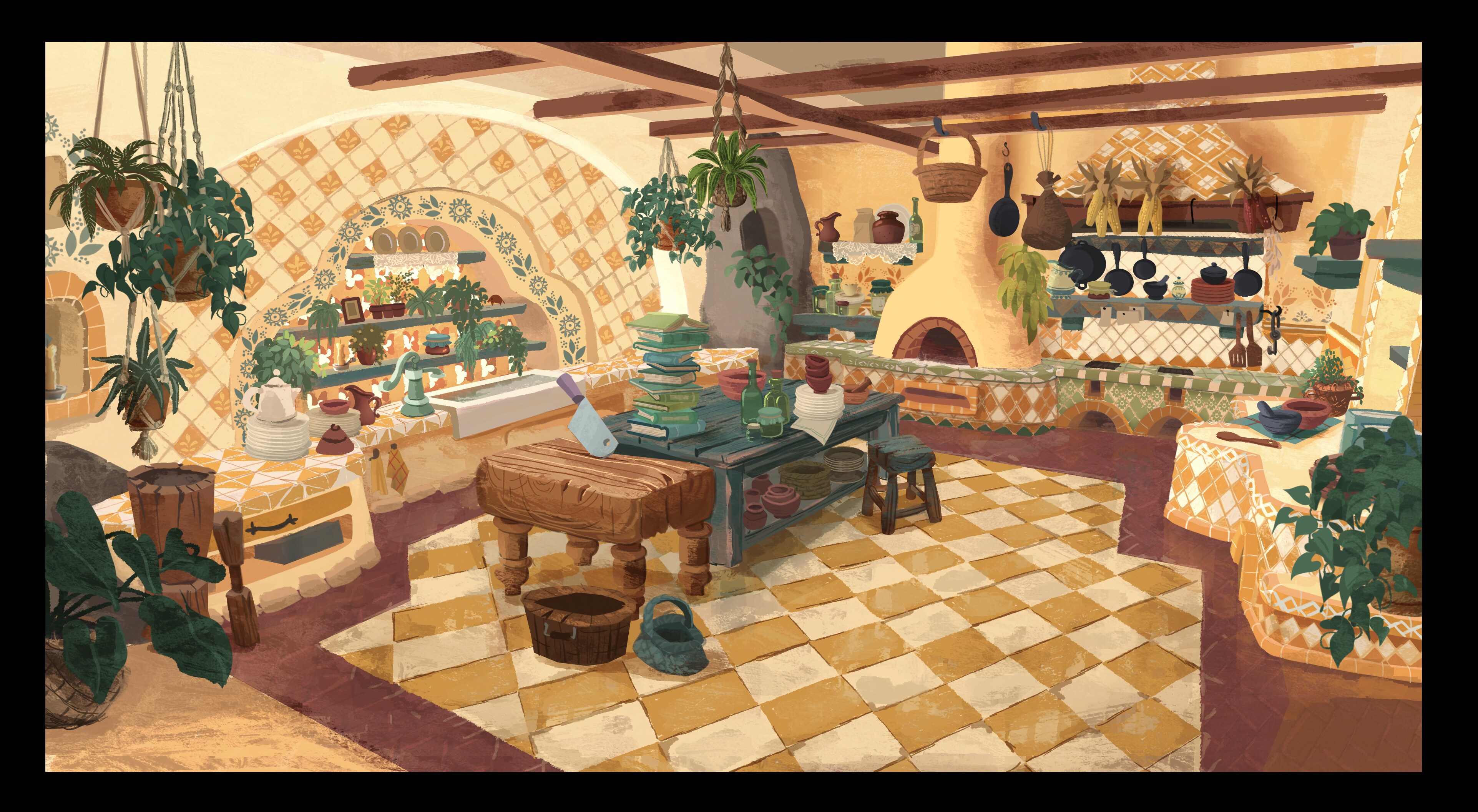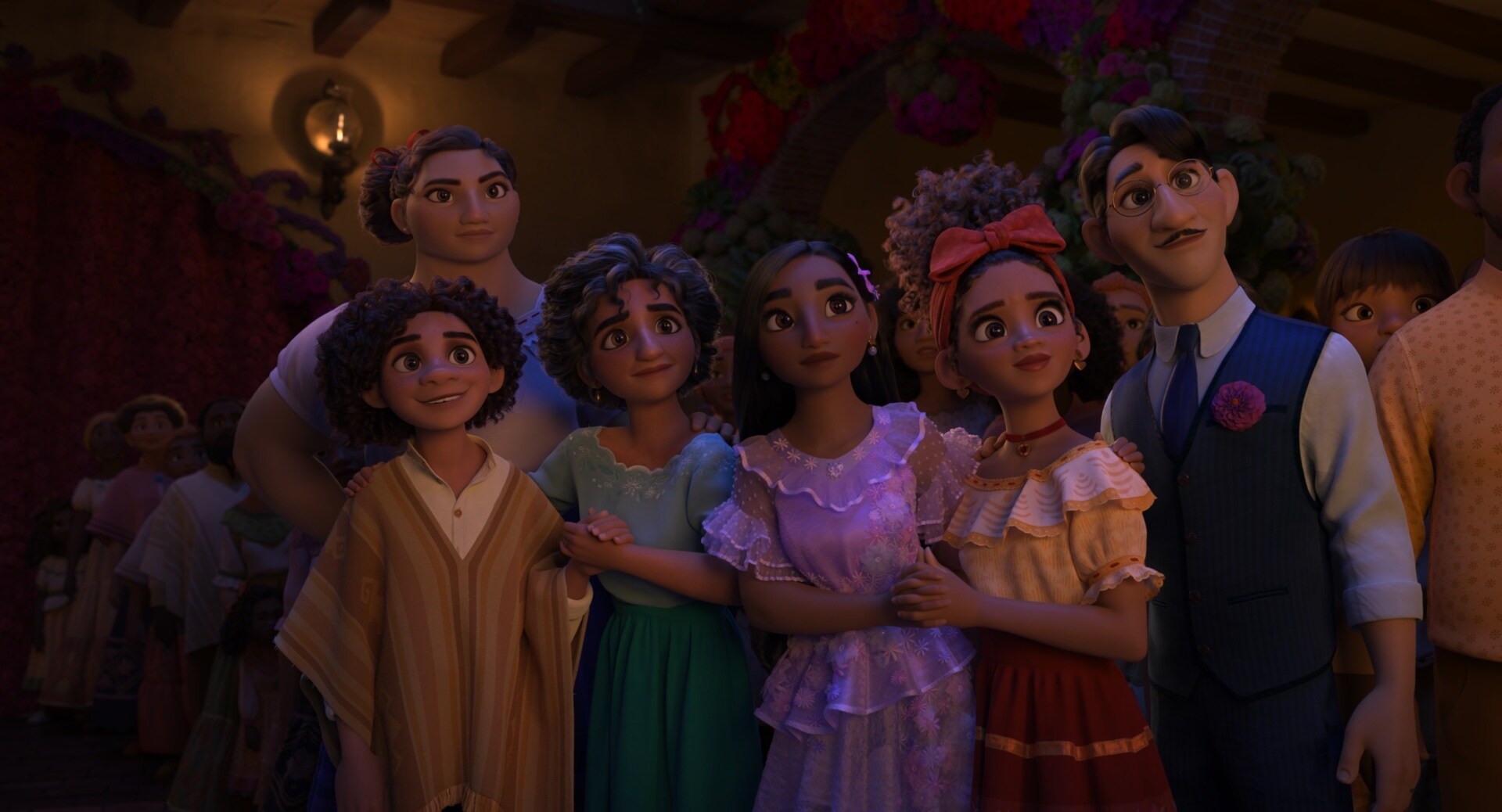
The time is drawing near for Walt Disney Animation Studios’ next movie, Encanto. A film about the complexities and interconnectedness of families, Encanto centers on the Madrigal family and their magical home, and particularly on Mirabel, the only member of her large family without a magical gift. Set in the South American country of Colombia and featuring music by Lin-Manuel Miranda, Encanto is the 60th animated feature from Walt Disney Animation Studios. Disney News sat in on a recent press conference where, for the first time, filmmakers shared a sneak peek into the process of making Encanto. Director Byron Howard, writer and director Jared Bush, writer and co-director Charise Castro Smith, producer Yvett Merino, producer and president of Walt Disney Animation Studios Clark Spencer, associate production designer Lorelay Bové, head of animation Renato dos Anjos, head of animation Kira Lehtomaki, and animation reference consultant Kai Martinez all spoke about their part in the process of creating the film.
The journey that would end up taking five years, eight internal screenings, and hundreds of script drafts all started with directors Byron Howard and Jared Bush, who previously teamed up on the Oscar-winning film Zootopia. Having each worked on musicals separately in the past — Howard directed Tangled, and Bush was screenwriter on Moana — and sharing a love of music (both are trombonists), they wanted to tackle one together. Bush had collaborated with Lin-Manuel Miranda on Moana, and so Miranda was brought onto the project from the very beginning. This was unique to Encanto: songwriters are not typically brought on so early in the process of creating an animated musical. The three brainstormed, thinking about what they all had in common: family — specifically, large families. This led them to a central question they wanted to explore in the film, which Howard phrased as, “How well do we truly know our families, and how well do our families know us?” They figured everyone has complicated, interesting families, and so this would be a universal experience for their story to tell.
The complex dynamics between large families seemed like a rich area to explore, and they realized that setting the movie in Latin America — especially Colombia, considered the crossroads of Latin America — made a lot of sense, as family is very important in Latin American cultures. Howard and Bush had met Juan Rendon and Natalie Osma, both originally from Colombia, when they filmed a behind-the-scenes documentary on Zootopia for the network Fusion, and the four had remained friends. They heard from Rendon and Osma that is rich in cultural diversity, with Spanish, African and Indigenous people, among many others who have come to this crossroads of Latin America. As Bush put it, they learned the country is “a melting pot of Latin culture, music, dance, art and food, with some of the greatest biodiversity on the planet, and also [is the] home of magical realism,” referring to literary work by authors such as Colombian novelist Gabriel García Márquez. It seemed perfect, so in 2018 the creative team took a trip to check out Colombia for themselves. They visited big cities like Bogotá and Cartagena, small towns like Barichara, Salento, and Palenque, and natural landmarks like the Valle de Cocora. In Colombia, the team encountered a phenomenon they’d read about in their research — encantos, or places of natural wonder with heightened spirituality, spots where emotion-related magic happens. Of this discovery, Howard shares, “[It] was amazing because we were looking for a way to incorporate magic into the movie. It felt very important to do that, but in a way that felt specific to Latin America, and [to] combine [that] with this idea — inspired by magical realism — where magic is everywhere. It's tied to emotion and roles in the family. That all seemed to really speak to each other.” And so the team had a title for the movie: Encanto.

Soon after the group returned from Colombia, they realized they needed to bring another writer on. After reading hundreds of scripts, Bush and Howard knew immediately after reading Charise Castro Smith’s script that she was the collaborator they were looking for. Castro Smith not only joined as a writer but also became a co-director of the film. As to why she’s drawn to this type of storytelling, she explains, “The language of magical realism just makes visceral sense to me. It’s woven into my imaginative DNA. Growing up in Miami, a place where fact often felt stranger than fiction, the tall tale of a story often felt like the best way to capture the reality of a given event. Still does.” Magical realism was the missing piece that brought the story of Encanto to life.
From the beginning, in addition to Rendon and Osma, the creative team worked with both internal and external resources to make sure the film was as authentic as possible. They put together a Colombian Cultural Trust, consisting of experts in music, anthropology, culture, architecture, and botany, among other subjects, who helped guide them on big-picture topics down to the smallest details. Producer Yvett Merino explains the process of working with the trust: “They really came on very early on, working with Lorelay [Bové] and the art team, and then carried on through our asset team as we actually started building all the assets. There was an ongoing meeting and collaboration with them, just to make sure that we were representing [everything] correctly.” Internally in Walt Disney Animation Studios, artists and studio employees formed a group called Familia that also advised the filmmakers. The filmmakers were aware that Colombia is not a monolith, with Howard pointing out, “Colombia is like many countries packed into one, so we had to be careful not to just ask our consultants from one region. We had to have coastal consultants, and consultants from Cali and Bogotá, and everywhere in the country as much as possible.” And so these teams, through their research, insight, and personal experiences, helped to elevate the project.

One important aspect of the movie that the Colombian Cultural Trust was able to advise on was the Madrigal family home. As Charise Castro Smith puts it, “We had a big breakthrough [when] we realized that the family’s house didn’t have to just be a house — because in an encanto, the house itself could have powers, too.” Casa Madrigal, the magical home of the Madrigal family, is full of personality; Bush says, “It’s a house that plays favorites, like families do.” From a production design standpoint, the house was inspired by traditional Colombian homes in Barichara, Cartagena, and Salento. With the kitchen in particular — a gathering place in the home — consultants steered the team toward a more neutral color palette. Says associate production designer Lorelay Bové, “We added some props that would be found in a cocina Colombiana like a molinillo, which is a hot chocolate stirrer, or a corn grinder, and traditional clay pottery called La Chamba.”
The house was an important character in its own right. Howard explains, “We played with the idea of the physical house as a literal representation of the family and their emotional connections. For instance, if the family’s happy, the house is healthy. If the family’s being playful, the house can be playful. But if the family is going through struggles, the house can crack.” Renato dos Anjos, head of animation, says the house was one of the most challenging elements in the film: “It's this living, breathing thing that, anywhere you are in the scene, there's something moving with how it emotes through the house. You know — how does the house feel a certain way, and how does she express that to a character?” Colombian architects advised the production that these homes often have an indoor-outdoor feel. This caused them to add a beautiful courtyard to the home, “where you can see all the magical doors. Each family member has a uniquely designed room,” says Bové. To that measure, each of the Madrigal family members with magic powers have their own room that represents their unique gifts. Through Antonio’s door, working with a botanist consultant, the team paid homage to Colombia’s robust biodiversity.

Encanto follows three generations of the Madrigal family. The matriarch is Abuela Alma, who first brought the family to the encanto and forged a new life for them there. Castro Smith describes the character, “Abuela Alma’s steely strength and single-minded determination to protect her family hasn’t wavered in 50 years since she lost her husband.” And of course, the visuals are designed to complement the characters’ stories. For Abuela Alma, Bové explains, “Since our Abuela Alma had lost her beloved husband and goes through so much, her costume color palette and her character design has a lot of weight and feels more constrained than other characters. She has more of a traditional 1900s look... a little more conservative.”

The movie’s protagonist, Mirabel, is in the third generation of Madrigals who live in the encanto, but is the only one without a magical gift. Director Byron Howard shares of her journey, “After spending her entire life trying to measure up to the rest of the Madrigals, Mirabel finds that she is the only one who can save her beloved family and their magical home.” Designing the character of Mirabel, a collaborative process led by art director of characters Bill Schwab, was crucial to the film. Early on the team decided that Mirabel’s outfit would be filled with handmade, fun, and imperfect embroidery, “sort of like what a teenager would do in a diary with their drawings,” says Bové. Their anthropologist consultants were able to provide the teams with authentic examples from which to draw. Continuing with the theme of imperfection, head of animation Renato dos Anjos explains, “Mirabel, as she’s moving around, sometimes makes little mistakes here and there, and that’s because she often feels a little bit awkward and out of place.” The character was only perfect once they found her imperfections. Dos Anjos’ fellow head of animation Kira Lehtomaki shares, “I think on an emotional level, Mirabel was actually a really difficult character because she was somebody that was really, in the depths of her soul, trying to understand why she wasn't given this gift. And yet she exudes kind of this upbeat, ‘it doesn't bother me’ kind of attitude through a lot of it. But finding that right balance was really, really tricky.”

In figuring out what character received what gift, writer and co-director Charise Castro Smith explains, “We realized that if the family in our story lived in one of those magical encantos, maybe the children born there would be special — but special in a way that is a nod to family dynamics that we can all relate to, that we all know.” She describes how each gift ties into the role the character plays in the family: “Like the strong, dependable child who is the rock of the family, or the perfect golden child whose happiness blossoms, or the quiet kid who isn’t comfortable talking to people, and so he talks to animals.”
Mirabel’s nuclear family consists of her mother, Julieta, whose magical power is the ability to heal through food; her father Agustín, who married into the family and thus doesn’t have a magical power; her oldest sister Isabela, who has the power to make plants grow and flowers bloom; and her middle sister Luisa, who has the power of superstrength. From a production design standpoint, Bové explains, “Visually in our department we wanted to make sure to organize the families through distinct color palettes, to make sure that our audiences can track who’s who and which member is from each side of the family. We have Julieta and Agustín’s side of the family, which is Mirabel’s side of the family, more in jewel tones and cooler tones.” Julieta’s healing power ensures that she’s the family caretaker. “Agustín is very accident-prone and he tends to get hurt a lot,” Howard laughs. “It is actually a perfect situation that he married a healer.”
Isabela, the eldest daughter, is effortlessly graceful and is the golden child of the family, while middle sister Luisa is the rock of the family who solves problems and holds everyone together. However, they may not be happy with the roles they’ve been assigned. In contrast with the way Mirabel moves, Isabela’s movements are always perfect. Dos Anjos shares that for Isabela, “We always wanted her to feel that if you see her anywhere in the movie, even if she’s not the main character in the shot, that she still looks very elegant and great in every angle. She knows she’s always on stage.” Isabela’s character design matches her movements and signifies her special gift. “Another inspiration for Isabela’s costume and her room was flower festivals in Colombia, especially the one from Medellín. And we designed, for her dress and her environment, a lot of dahlias, hydrangeas, orchids, daisies, amongst other flowers from Colombia,” says Bové. Luisa also moves effortlessly, though with a physicality more fitting to her power of superstrength — the animators “found a lot of inspiration looking at movement of female shot put athletes,” says dos Anjos.

Julieta’s siblings, Pepa and Bruno, are the other branches in Mirabel’s extended family. Bruno is estranged from the family, and they don’t talk about him. Mirabel’s aunt Pepa has the ability to control the weather with her emotions… which are plentiful. Married to Pepa is Félix, who like Agustín was not born in the encanto and so doesn’t have powers, though he is “definitely the life of the party,” says writer and director Jared Bush. Pepa and Félix have three children: Dolores, who has the gift of extraordinary hearing; Camilo, who has the ability to transform his appearance at will; and Antonio, who Mirabel is closest to, and who has the gift of speaking with animals. Bové shares of their design, “Pepa and Félix’s side of the family have more of the warm color palette,” in contrast with Mirabel’s immediate family.
With such a diverse cast of characters, it’s no wonder the family dynamics are complicated. But the filmmakers hope that illustrates a point. “I'm really hoping the takeaway is that people realize they need to ask their family questions. They need to seek to understand them differently, and see parts of them that are hidden sometimes, and also show parts of themselves that they don't always bring into the light,” says Bush.
Get to know the Madrigal family and be sure to check out Walt Disney Animation Studios’ Encanto when it hits theaters Wednesday, November 24.
 Disney.com
Disney.com